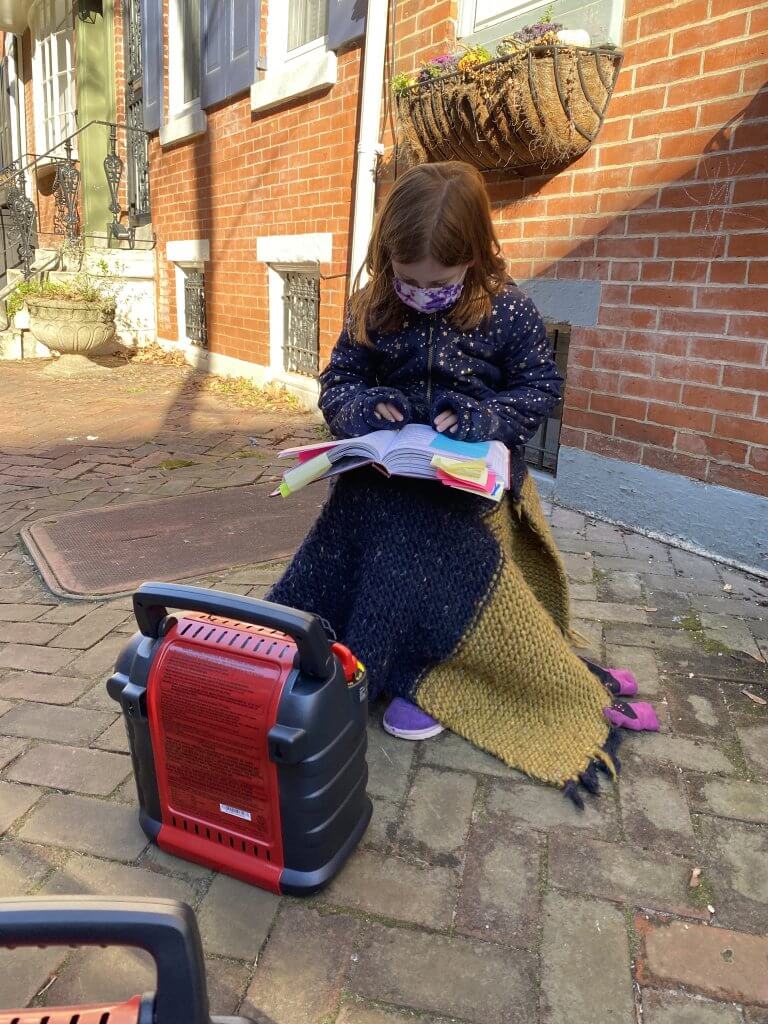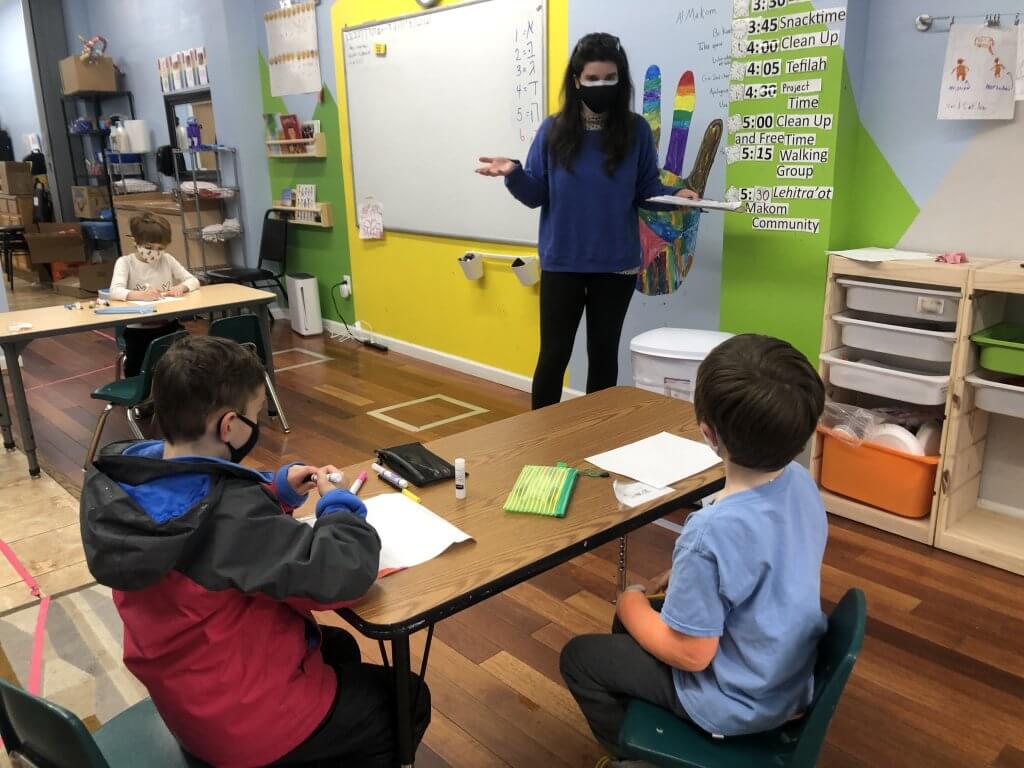
When we last left our heroes, Mordechai had finally convinced Esther to risk her own life by approaching Achashverosh uninvited and asking him to save her people. But when Esther visits the king, she asks instead for him and Haman to join her for a feast. Huh? What’s with that? And at the feast, she asks them to come to yet another feast!
Why did Esther invite them to two feasts?
- Because she’s hungry!
- To talk to them.
- To bribe Achashverosh into giving her what she wanted.
- It’s like giving someone presents before asking for what you want.
- She wanted them to eat a lot so they would do what she wanted.

The Nitzanim (3rd and 4th graders) dug a little deeper into Esther’s motivations by reflecting on the power dynamics in the story. How much power does each of these characters have?
- King Achashverosh: He has a lot of power because he’s the king.He’s in charge of 127 countries, that’s a lot of people.
- Queen Esther: She has a lot of power because she has access to the king, but not as much as she would have if she weren’t a woman.
- Mordechai: He starts out as a normal dude, but he becomes super important because he saved the king’s life and he saves the lives of all the Jews kinda.
- Haman: He is second in command and makes the decision to kill all of the Jews, so clearly people listen to him even if he is a little crazy.
- Bigtan and Teresh (two disgruntled palace guards): Their plan to kill the king was ruined so easily that it seems like they don’t have a lot of power.
- Zeresh (Haman’s wife): At first I thought she didn’t have a lot of power, but she’s the one that convinced Haman to get back at Mordechai, so it seems like she does have power.

We noticed that while Esther had a fair amount of power, she wasn’t able to make all the decisions and changes on her own. Esther’s approach to helping the Jewish people was more passive than active. She couldn’t fix the problem by herself – she had to talk to the king and get him to stop Haman. The Shorashim (1st and 2nd graders) delved deeper into this idea.
What does “active” mean?
- Full of energy!
- Doing stuff.
- If you see a dog, and you like dogs, the active thing to do would be to approach it and pet it.
- If someone throws trash on the ground, you might run to pick it up.
What does “passive” mean?
- Calm.
- Not doing things.
- It’s like if someone throws trash on the ground, you might ignore it.
- Or maybe you would talk to that person to get them to pick up the trash themselves.
What are passive ways I can make change?
- Writing letters to the president!
- Talking to other people about making better choices (like not littering).
- Telling people to vote.

In a brief hiatus from the main plot, the story focuses on the king, the night after Esther’s first feast, having an unexplained bout of insomnia. He asks his servants to read to him from his sefer divrei hayamim (the chronicles of his days as king) to help him sleep. They read to him about the time that two palace guards, Bigtan and Teresh, plotted to assassinate him, but Mordechai discovered their plan and saved him. Achashverosh realized then that he never repaid or thanked Mordechai for saving him.
We asked the Garinim (preK and K kiddos) what are some ways you might honor, thank, or show respect to someone?
- Hug them to death!
- Stand as still as a statue.
- Sing a goodnight song to help them sleep.
- Say thank you.
- Give them a stuffed animal.
- Be nice to them.
- Get rid of their enemies.

Assuming that the king means to honor him, Haman advises Achashverosh on an elaborate and public way to thank someone. Instead, Achashverosh told Haman to carry out his honoring plan with Mordechai, Haman’s sworn enemy! Haman was distraught. Just the sight of Mordechai sitting in the palace gate, refusing to bow was enough to ruin Haman’s whole day and outweigh all the power and favor he held in the kingdom. We looked at Haman’s character in these moments as a negative example of resilience. As one Shorashim kid put it, “I don’t think he can figure out how to solve his problems.”

While we agreed that Haman was not resilient, we wondered, what makes a resilient person? Here’s a recipe for resilience that we created with the Garinim, and examples of each ingredient that kiddos and teachers brought to their own resilient selves.
- Emotional awareness: recognizing feelings in myself and in others
- Chickie and duckie – I hug them when I’m having feelings.
- My taggy stuffed animals that I like to snuggle – they help me feel better when I’m sad or something goes a way I didn’t want.
- My Shoulds monster that I made to help me feel compassion towards myself.
- Journal – where I write and draw about my feelings and figure them out.
- My dog’s collar that was too small and noisy – because I’m sad about it.
- Problem solving: identifying and understanding problems and figuring out the steps to solve them
- Our brains because that’s what we use to solve problems.
- My computer – where I organize some information.
- My cat – she needs lots of things and I have to figure out what she’s asking me for or what I can help her with.
- My fidgets – show that I solved the problem of not being able to focus and then while I’m focusing I’m better at solving other problems.
- A book because it shows that I figured out how to read.
- Confidence: knowing and believing that I can do the thing!
- My timer – because it’s something that I know how to use.
- Legos – because I make them almost every day, I made a whole base out of them. I’m very good at Legos.
- My headstands and flips and gymnastics!
- A book for this also because I know I’m a good reader and I can use reading to calm down
We’re living through a particularly weird time, and everything feels extra hard. So here’s your reminder, if you need it: You’re not like Haman. You are resilient. Your kiddos are too. You’re going to get through the thing. Chag Purim Sameach – Happy Purim!
